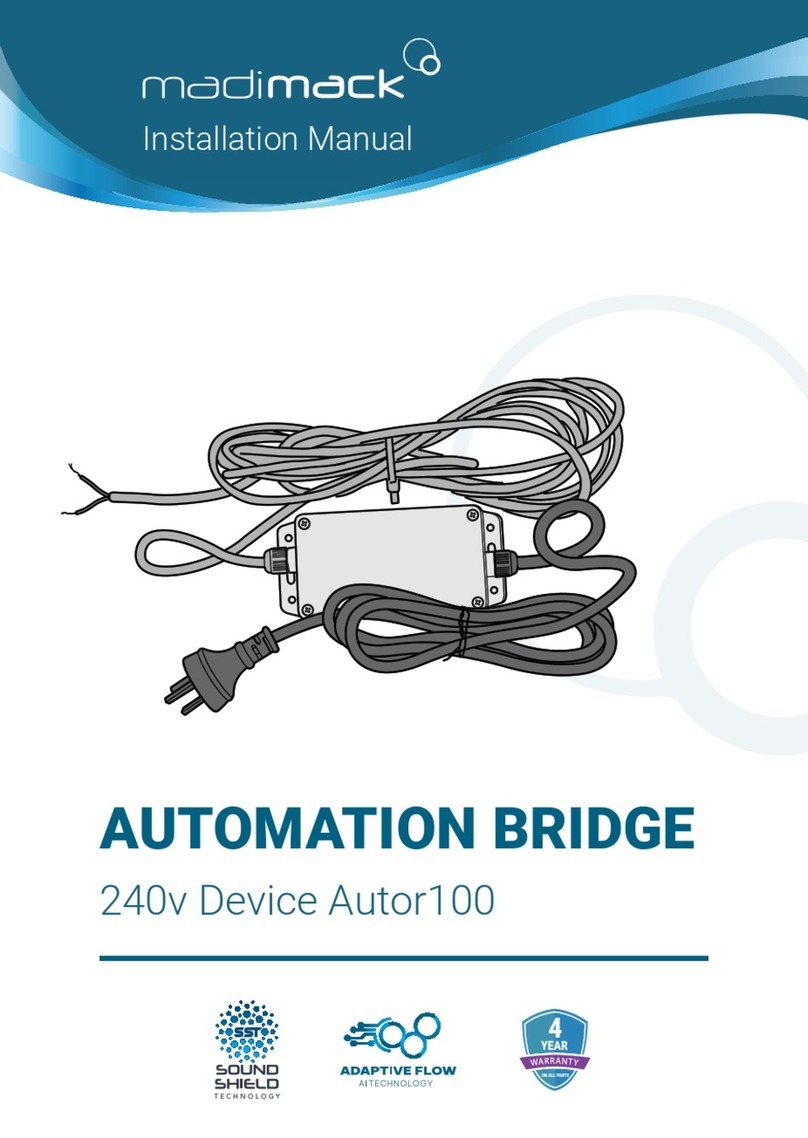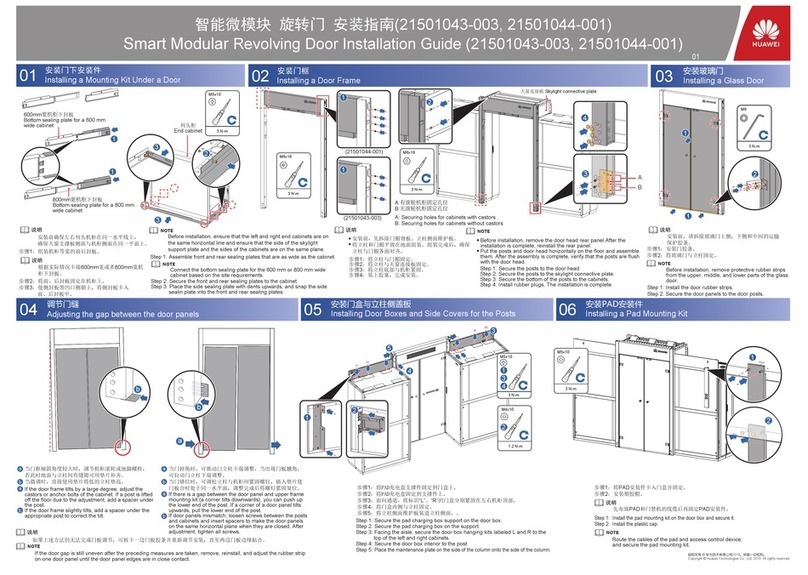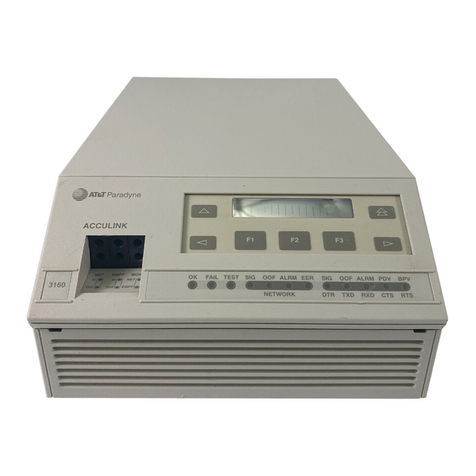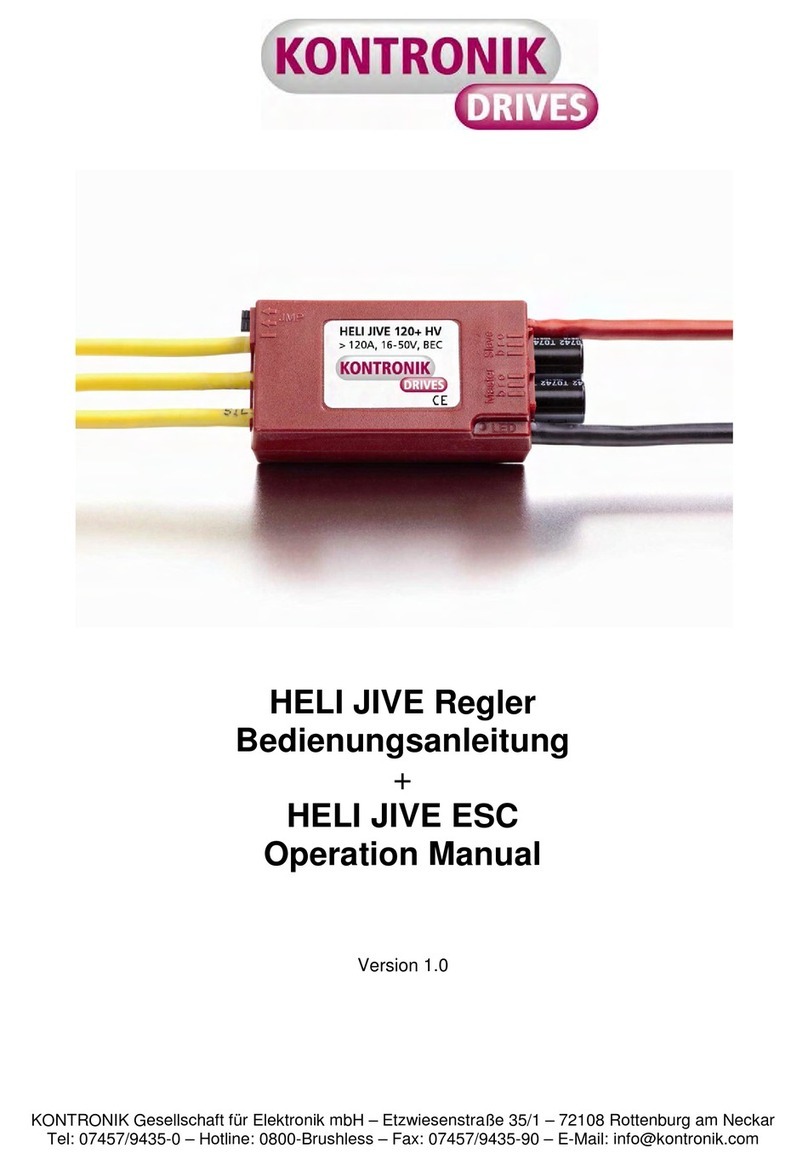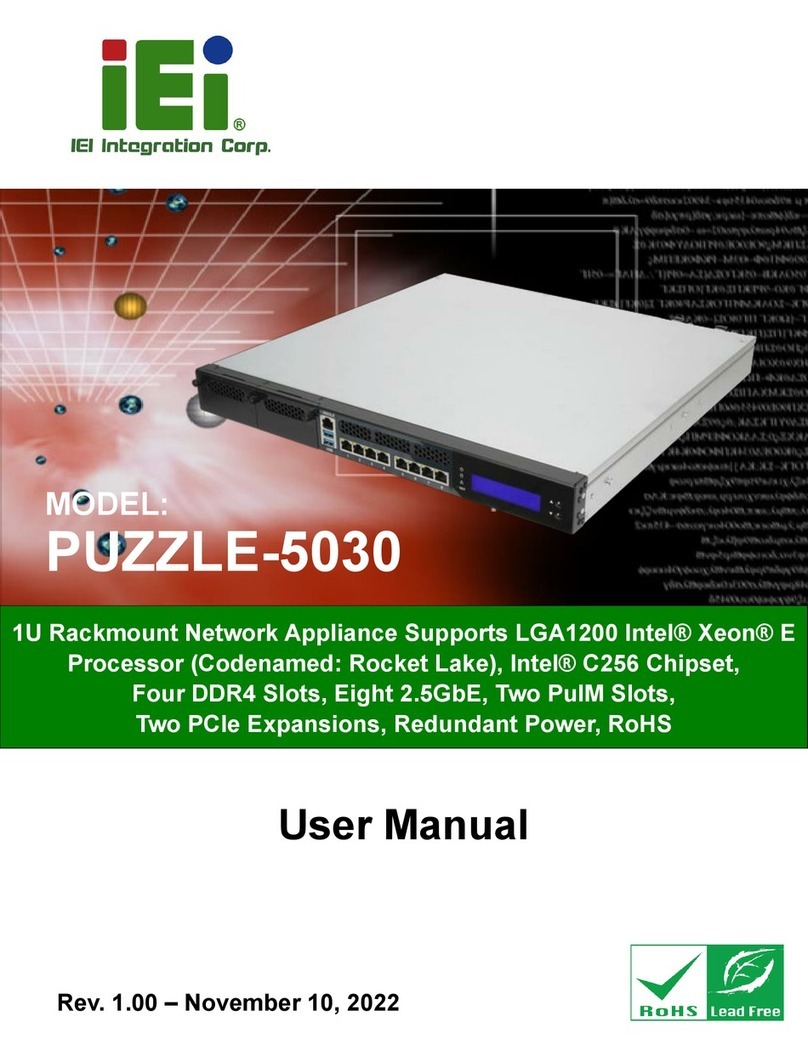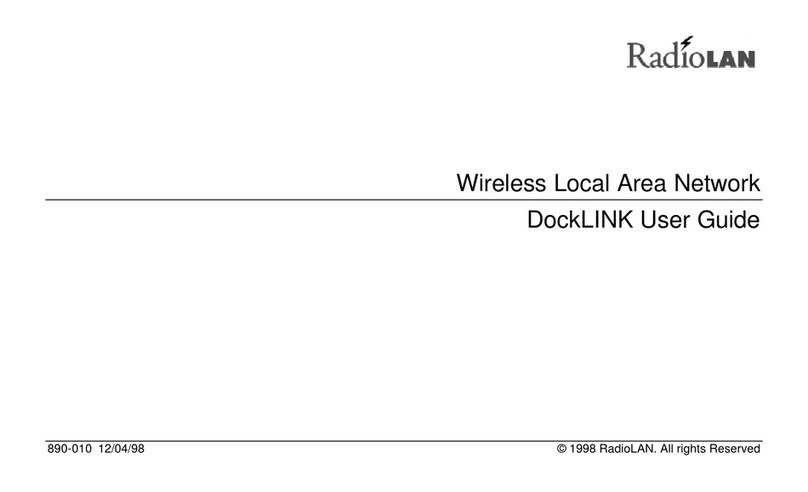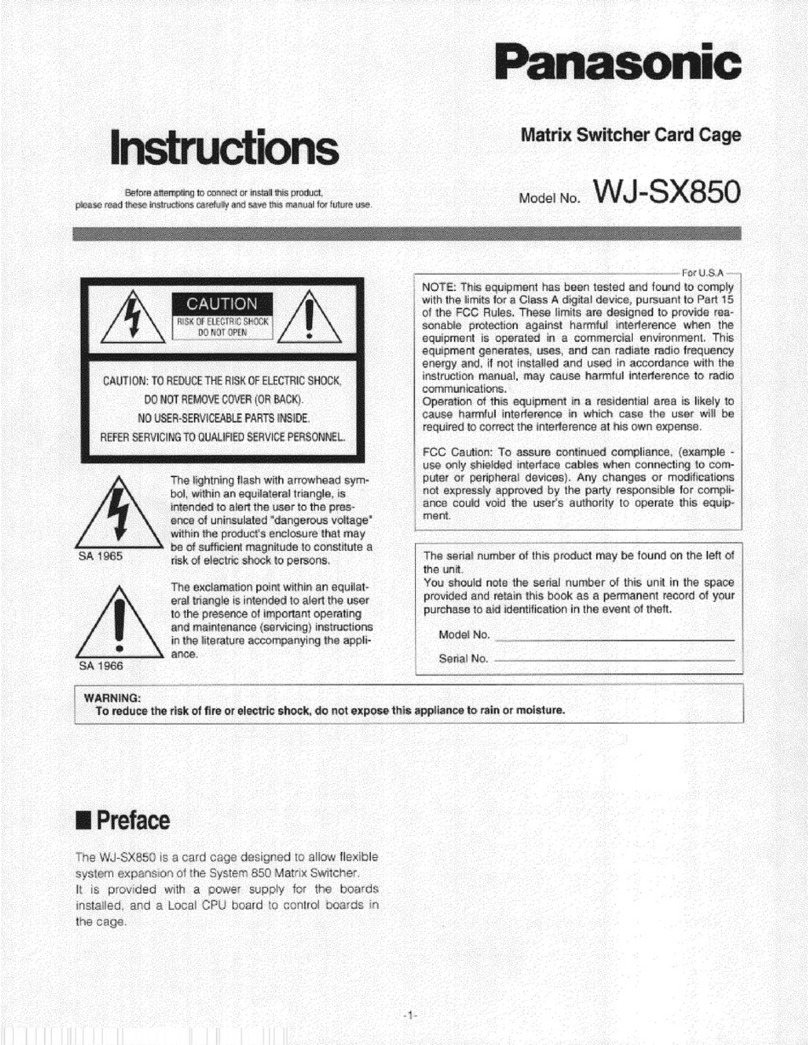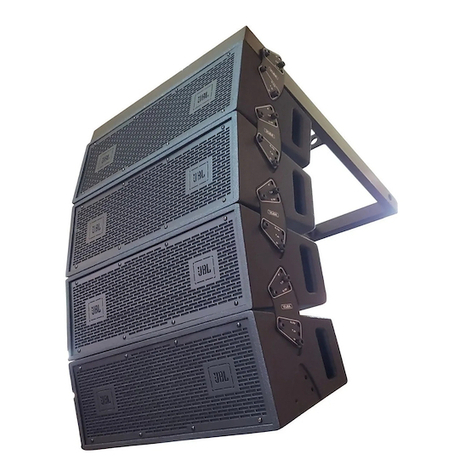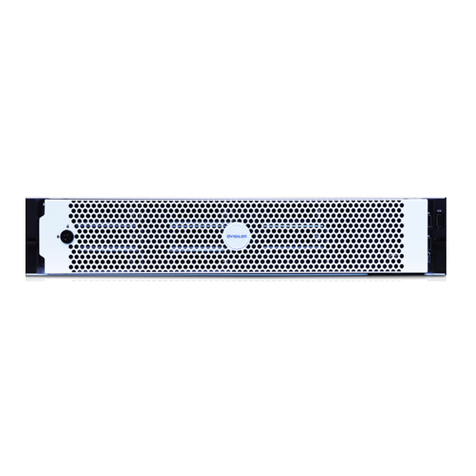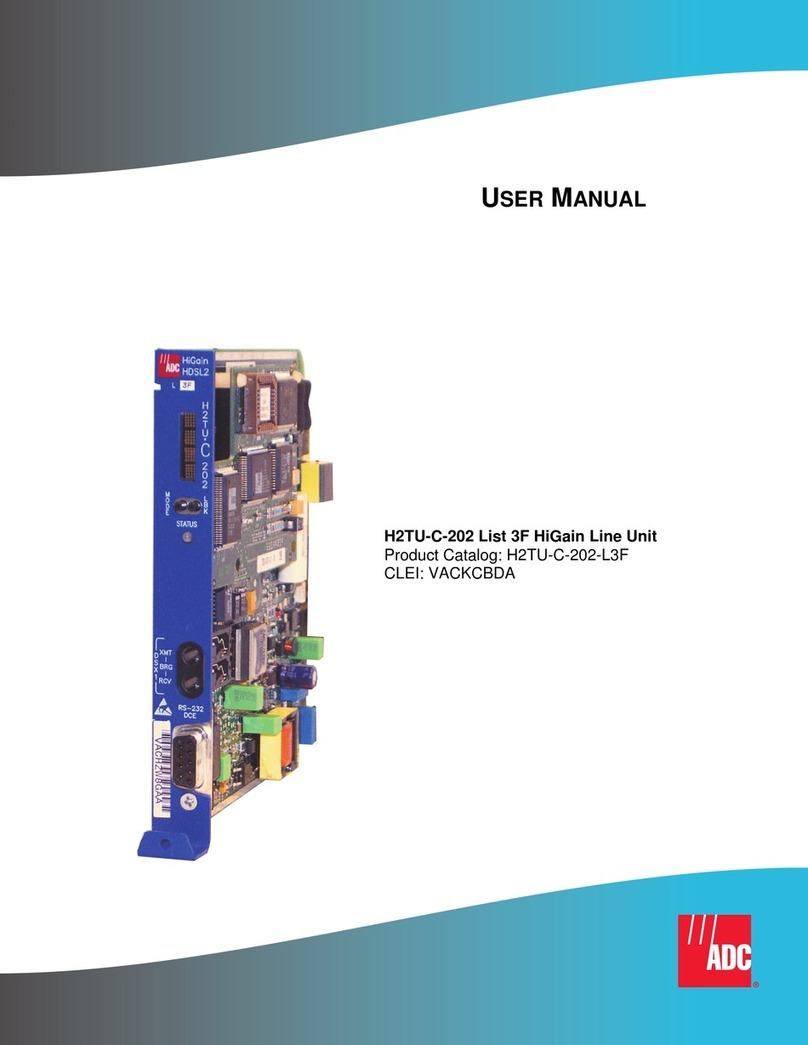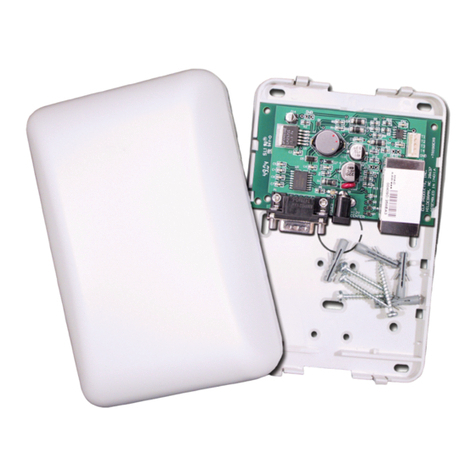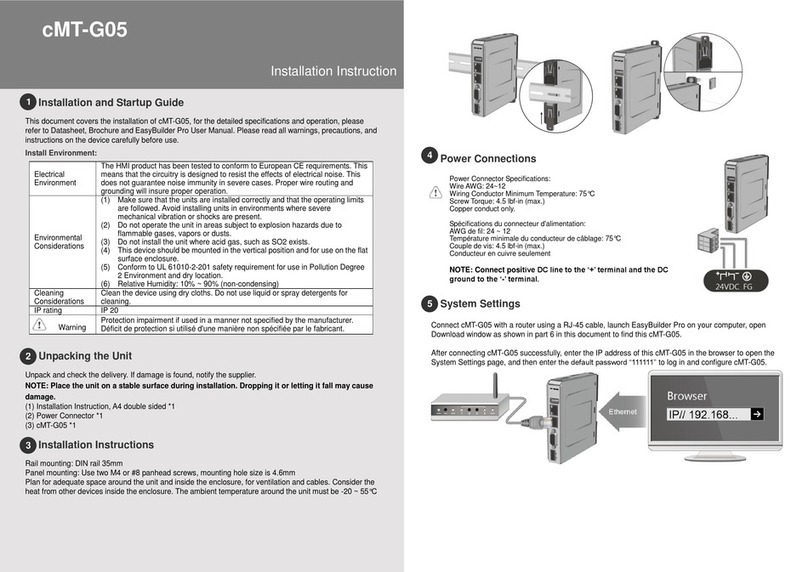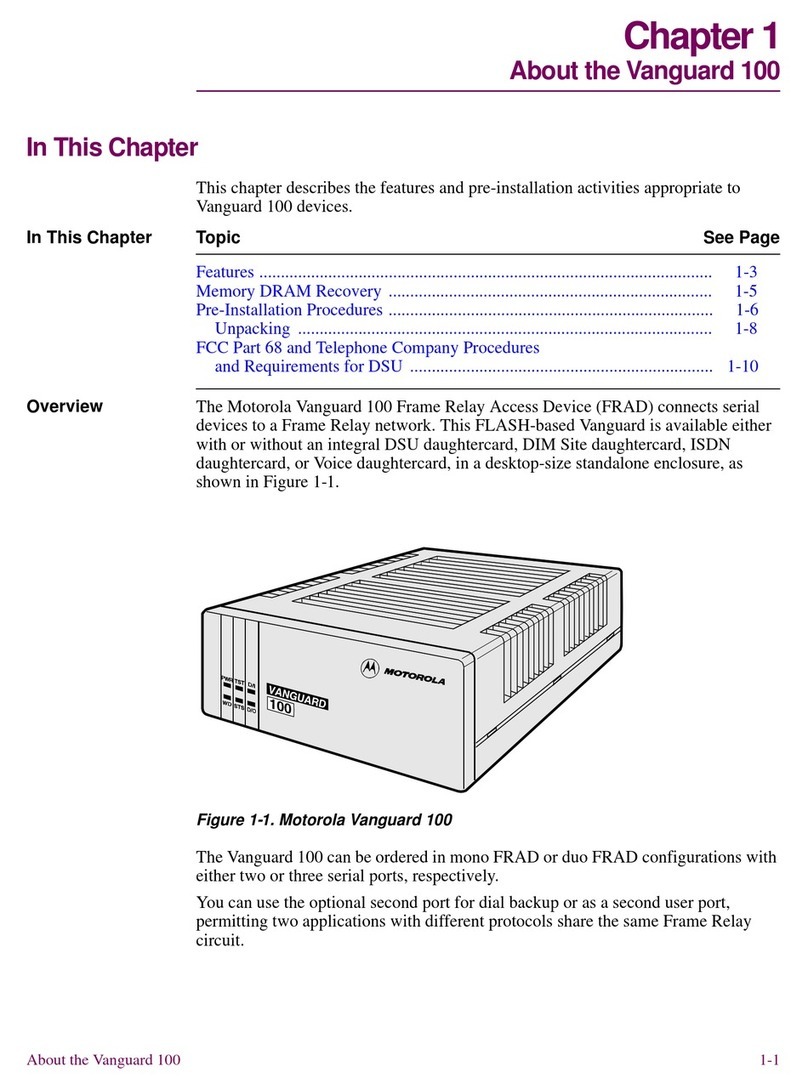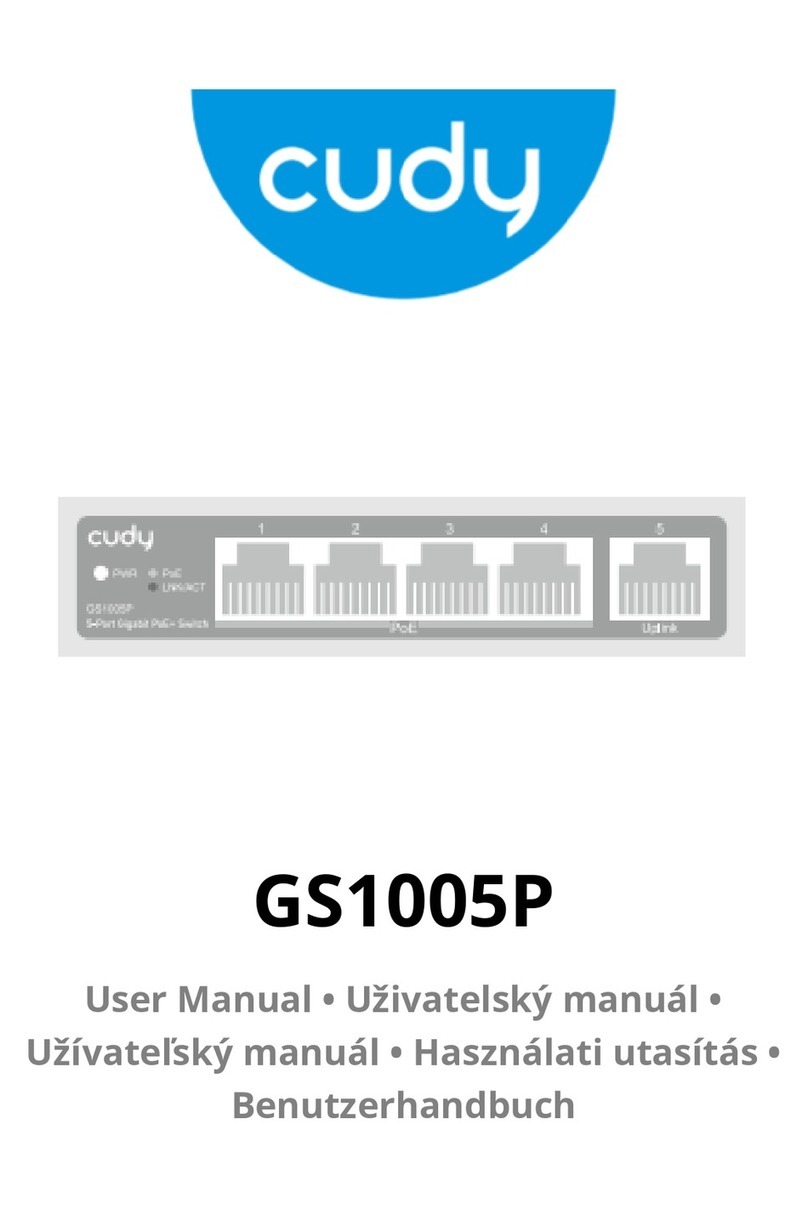Eilersen 4 50 Series User manual

4x50 EtherNetIP.190129.1v4: User manual
WWW.EILERSEN.COM
Version: 2020-11-24, rev.: 1v4 Page: 2
1) Contents
1) Contents .................................................................................................................. 2
2) Introduction.............................................................................................................. 4
2.1 Introduction ......................................................................................................... 4
2.2 Connection of power supply .................................................................................... 4
2.3 ATEX (Ex) specification .......................................................................................... 4
2.4 EtherNetIP specification ......................................................................................... 5
3) Data Exchange .......................................................................................................... 6
3.1 EtherNetIP communication ..................................................................................... 6
3.1.1 Output data .................................................................................................... 7
3.1.2 Input data (LcSignal, Normal operation, AS=0) ................................................... 8
3.1.3 Input data (LcSignalFiltered, AS=1) ................................................................... 9
3.1.4 Input data (LcSignalUnFiltered, AS=2) ............................................................... 9
3.1.5 Input data (LcSerialNumber, AS=3) ................................................................. 10
3.1.6 Input data (LcCapacity, AS=4) ........................................................................ 10
3.1.7 Input data (LcExponent, AS=5) ....................................................................... 11
3.1.8 Input data (TestValue, AS=6) ......................................................................... 12
3.1.9 Input data (SoftwareVersion, AS=7) ................................................................ 13
3.2 Data formats ...................................................................................................... 14
3.2.1 Unsigned integer format (16 bit) ..................................................................... 14
3.2.2 Signed integer format (32 bit)......................................................................... 14
3.3 Scaling............................................................................................................... 15
3.4 Measurement time .............................................................................................. 15
3.5 Filtering ............................................................................................................. 16
4) Data Processing ...................................................................................................... 17
4.1 Zeroing, calibration and weight calculation ............................................................. 17
4.1.1 Zeroing of weighing system ............................................................................ 17
4.1.2 Corner calibration of weighing system .............................................................. 18
4.1.3 Calculation of uncalibrated system weight......................................................... 18
4.1.4 System calibration of weighing system ............................................................. 19
5) Installation of System .............................................................................................. 20
5.1 Checklist during installation .................................................................................. 20
6) Hardware Description............................................................................................... 21
6.1 4x50 overview .................................................................................................... 21
6.2 4x50 front panel description ................................................................................. 21
6.2.1 Connection of power ...................................................................................... 21
6.2.2 Connection of load cells .................................................................................. 22
6.2.3 RS232 connector (J4)..................................................................................... 22
6.2.4 Ethernet connector ........................................................................................ 22
6.2.5 SW1 settings................................................................................................. 22
6.2.6 SWE settings................................................................................................. 23
6.2.7 Light Emitting Diodes (LEDs)........................................................................... 23
6.3 Hardware Selftest................................................................................................ 24
6.4 Update times ...................................................................................................... 24
7) Appendices ............................................................................................................. 25
7.1 Appendix A: Connection of power .......................................................................... 25
7.1.1 Non-ATEX applications ................................................................................... 25
7.1.2 ATEX applications .......................................................................................... 26
7.2 Appendix B –Configuration using EEConnect software ............................................. 27
7.2.1 Change of IP Address, SubNet mask etc. .......................................................... 27
7.2.2 Download of new software .............................................................................. 27
7.3 Appendix C –Allen Bradley connection................................................................... 28
7.4 Appendix D –Omron connection ........................................................................... 28
7.5 Appendix E –Internal Features ............................................................................. 29

4x50 EtherNetIP.190129.1v4: User manual
WWW.EILERSEN.COM
Version: 2020-11-24, rev.: 1v4 Page: 3
7.5.1 4050 Ethernet module.................................................................................... 29
7.5.2 SW2 settings................................................................................................. 29
7.5.3 Light Emitting Diodes (LEDs)........................................................................... 29
7.5.4 4040 communication module .......................................................................... 29
7.5.5 SW2 settings................................................................................................. 30
7.5.6 Jumper settings............................................................................................. 30
7.5.7 Light Emitting Diodes (LEDs)........................................................................... 31
7.6 Appendix F –Status Codes ................................................................................... 32

4x50 EtherNetIP.190129.1v4: User manual
WWW.EILERSEN.COM
Version: 2020-11-24, rev.: 1v4 Page: 4
2) Introduction
2.1 Introduction
This document describes the use of a 4x50 Ethernet system unit from Eilersen
Electric. The 4x50 system unit consists internally of a 4050 Ethernet module
(with the software listed on the front page) and a 4040 communication mod-
ule.
The 4x50 system unit is connected to X load cells (1-4). With the program
specified on the front page, the 4x50 Ethernet unit is capable of transmitting
weight and status for up to 4 load cells in a single telegram. The 4x50 Ether-
net unit is also capable of transmitting load cell information (such as serial
number, capacity and exponent) instead of the normal weight signals. This is
all determined by the Actual Value Selector (AS) written to the 4x50 Ether-
net unit from the EtherNetIP master.
It is possible to connect the 4x50 Ethernet unit to an EtherNetIP network,
where it will act as a slave. It will then be possible from the EtherNetIP master
to read status and weight for each of the connected load cells. Functions as
zeroing, calibration and calculation of system weight(s) must be implemented
outside the 4x50 in the EtherNetIP master.
By use of DIP-switches it is possible to select measurement time and include
one of 15 different FIR filters, which will be used to filter the load cell signals,
as well as selecting the desired scaling of the load cell signals.
Exchange of data between master and slave takes place as described in the
following.
2.2 Connection of power supply
IMPORTANT: Connection of power supply (24VDC) MUST be made to
BOTH the green two pole power connectors (J2 and J3) as specified on
the front panel of the 4x50 unit.
IMPORTANT: In regards to ATEX installations each of the green two
pole power connectors (J2 and J3) MUST be connected to EACH of
their own SEPARATE power supply as described later; see “7.1 Appen-
dix A: Connection of power”.
2.3 ATEX (Ex) specification
IMPORTANT: Instrumentation (the 4x50A) must be placed outside the
hazardous zone if the load cells are used in hazardous ATEX (Ex) area.
Furthermore, only ATEX certified load cells and instrumentation can be
used in ATEX applications.

4x50 EtherNetIP.190129.1v4: User manual
WWW.EILERSEN.COM
Version: 2020-11-24, rev.: 1v4 Page: 5
2.4 EtherNetIP specification
The EtherNetIP unit confirms with the following EtherNetIP specifications:
Protocol: EtherNetIP
Media: Ethernet
Module type: Slave(/Target)
Communication settings 10MB/s, Half duplex
IP-Address: Fixed (default: 192.168.1.199)
Ethernet connection: RJ45/Cat5
System setup: Ethernet using EEConnect software
Software download: Ethernet using EEConnect software

4x50 EtherNetIP.190129.1v4: User manual
WWW.EILERSEN.COM
Version: 2020-11-24, rev.: 1v4 Page: 6
3) Data Exchange
3.1 EtherNetIP communication
EtherNetIP communication with the 4x50 Ethernet unit uses a single Assembly
consisting of 2 output bytes (to the 4x50) as specified in the EDS file:
Assembly: Assem2 Output
Assembly instance: 102 (0x66)
Connection: Connection1 Exclusive Owner
Transfer class: Class 1
EtherNetIP communication with the 4x50 Ethernet unit also uses a single As-
sembly consisting of 26 input bytes (from the 4x50) as specified in the EDS
file:
Assembly: Assem3 Input
Assembly instance: 103 (0x67)
Connection: Connection1 Exclusive Owner
Transfer class: Class 1
In the following the byte order for the individual parts of the telegrams is LSB
first. In the following bit 0 will represent the least significant bit in a register.

4x50 EtherNetIP.190129.1v4: User manual
WWW.EILERSEN.COM
Version: 2020-11-24, rev.: 1v4 Page: 7
3.1.1 Output data
The 2 output data bytes (to the 4x50 unit) are structured like this:
Lc
Register
Byte 0 (LSB)
Byte 1 (MSB)
7
6
5
4
3
2
1
0
15
14
13
12
11
10
9
8
-
-
-
-
-
-
-
-
-
-
-
-
AS
LcRegister is a word (two bytes) that constitutes a bit register consisting of
16 bits (bit 0–15). Bit 8-11 in the LcRegister (the 4 least significant bits of
the most significant byte) are used as an Actual Value Selector (AS).
The other bits in the LcRegister of the output data are NOT used.
The Actual Value Selector (AS) is used as a request to select the actual in-
put data transferred from the 4x50 unit back to the EtherNetIP master. Once
the AS in the response coming back from the 4x50 unit matches the AS in the
request sent to the 4x50 unit, then the EtherNetIP master knows the data
transferred correspond to the requested data. The following data transfers can
be requested using the Actual Value Selector (AS) and are described in de-
tail below:
Actual Value Selector
(AS)
Transfer
0
LcSignal(X): Load cell signals (normal operation) (filtered and scaled)
1
LcSignalFiltered(X): Load cell signals (filtered but not scaled)
2
LcSignalUnFiltered(X): Load cell signals (not filtered and not scaled)
3
LcSerialNumber(X): Load cell serial numbers
4
LcCapacity(X): Load cell capacities
5
LcExponent(X): Load cell exponents
6
TestValue(X): Test values
7
SoftwareVersion(X): Software version installed in module.
IMPORTANT: Before using the input data described below, the EtherNetIP
master must ensure the AS response value in the input data (from 4x50)
matches the AS request value in the output data (to 4x50).

4x50 EtherNetIP.190129.1v4: User manual
WWW.EILERSEN.COM
Version: 2020-11-24, rev.: 1v4 Page: 8
3.1.2 Input data (LcSignal, Normal operation, AS=0)
This chapter describes the input data when the Actual Value Selector (AS) is
set to 0during normal operation.
The 26 input data bytes (from the 4x50 unit) are structured like this:
Lc
Register
Lc
Status(0)
Lc
Data(0)
Lc
Status(3)
Lc
Data(3)
0
1
2
3
4
5
6
7
20
21
22
23
24
25
LcRegister is a word (two bytes) that constitutes a bit register for indication
of expected load cells. Hence bit 0-3 will be ON, if the corresponding load cell
address (LC1-LC4) was expected to be connected. LcRegister is always trans-
ferred in 16 bit unsigned integer format.
In addition the LcRegister also contains the Actual Value Selector (AS) as
previously described above in the 3.1.1 Output data. The AS is located in the
same bit positions (bit 8-11) in the input data as in the output data.
Furthermore bit 15 will be always ON, while bit 14 will toggle ON and OFF with
1hz (=500ms ON, 500ms OFF).
LcStatus(X) is a word (two bytes) that constitute a register containing the
actual status for load cell X. LcStatus(X) is always transferred in 16 bit un-
signed integer format. During normal operation this register will be 0, but if
an error occurs some bits in the register will be set resulting in an error code.
A description of the different error codes can be found in Appendix F –Status
Codes.
LcData(X) is a double word (four bytes) constituting a register, which during
normal operation (AS=0) contains the LcSignal(X). The LcSignal(X) is the
actual weight signal from load cell Xin 32 bit signed integer format. Note
that the LcSignal(X) value is only valid if the corresponding LcStatus(X)
register is 0 indicating no error present. Also note the LcSignal(x) transferred
during normal operation is filtered and scaled using the selected DIP switch
settings (SWE) as described below.
Since only status and weight for the load cells are transmitted in the telegram,
functions such as status handling, calculation of system weight(s), zeroing and
calibration must be implemented on the EtherNetIP master. Please refer to
the chapter 4) Data Processing for an explanation on how this typically can be
done.

4x50 EtherNetIP.190129.1v4: User manual
WWW.EILERSEN.COM
Version: 2020-11-24, rev.: 1v4 Page: 9
3.1.3 Input data (LcSignalFiltered, AS=1)
This chapter describes the input data when the Actual Value Selector (AS) is
set to 1during transfer of LcSignalFiltered(X). The 26 input data bytes
(from the 4x50 unit) are structured exactly like during normal operation
(AS=0), except for the differences listed in the following:
LcRegister is 100% identical to LcRegister during normal operation (AS=0),
except the AS will be set to 1.
LcStatus(X) is 100% identical to LcStatus(X) during normal operation
(AS=0), except the LcStatus(X), will always have a bit set (see 7.6 Appendix
F –Status Codes) stating that LcSignal(X) is NOT selected (i.e. normal oper-
ation NOT selected).
LcData(X) will contain LcSignalFiltered(X) in the double word instead of
LcSignal(X) which is transferred during normal operation (AS=0). The
LcSignalFiltered(X) is the “raw”filtered signal from load cell X, which means
it is the load cell signal with filtering but without any scaling (based on the
LcExponent(X)) selected using the DIP switch settings (SWE).
3.1.4 Input data (LcSignalUnFiltered, AS=2)
This chapter describes the input data when the Actual Value Selector (AS) is
set to 2during transfer of LcSignalUnFiltered(X). The 26 input data bytes
(from the 4x50 unit) are structured exactly like during normal operation
(AS=0), except for the differences listed in the following:
LcRegister is 100% identical to LcRegister during normal operation (AS=0),
except the AS will be set to 2.
LcStatus(X) is 100% identical to LcStatus(X) during normal operation
(AS=0), except the LcStatus(X), will always have a bit set (see 7.6 Appendix
F –Status Codes) stating that LcSignal(X) is NOT selected (i.e. normal oper-
ation NOT selected).
LcData(X) will contain LcSignalUnFiltered(X) in the double word instead of
LcSignal(X) which is transferred during normal operation (AS=0). The
LcSignalUnFiltered(X) is the “raw”unfiltered signal from load cell X, which
means it is the load cell signal without any filtering or scaling (based on the
LcExponent(X)) selected using the DIP switch settings (SWE).

4x50 EtherNetIP.190129.1v4: User manual
WWW.EILERSEN.COM
Version: 2020-11-24, rev.: 1v4 Page: 10
3.1.5 Input data (LcSerialNumber, AS=3)
This chapter describes the input data when the Actual Value Selector (AS) is
set to 3during transfer of LcSerialNumber(X). The 26 input data bytes
(from the 4x50 unit) are structured exactly like during normal operation
(AS=0), except for the differences listed in the following:
LcRegister is 100% identical to LcRegister during normal operation (AS=0),
except the AS will be set to 3.
LcStatus(X) is 100% identical to LcStatus(X) during normal operation
(AS=0), except the LcStatus(X), will always have a bit set (see 7.6 Appendix
F –Status Codes) stating that LcSignal(X) is NOT selected (i.e. normal oper-
ation NOT selected).
LcData(X) will contain LcSerialNumber(X) in the double word instead of
LcSignal(X) which is transferred during normal operation (AS=0). The
LcSerialNumber(X) is the serial number from load cell X. The
LcSerialNumber(X) is transferred as a 7 digit decimal number, and has the
format YYXXXXX corresponding to the serial number (YY-XXXXX) marked on
the load cell itself.
3.1.6 Input data (LcCapacity, AS=4)
This chapter describes the input data when the Actual Value Selector (AS) is
set to 4during transfer of LcCapacity(X). The 26 input data bytes (from the
4x50 unit) are structured exactly like during normal operation (AS=0), except
for the differences listed in the following:
LcRegister is 100% identical to LcRegister during normal operation (AS=0),
except the AS will be set to 4.
LcStatus(X) is 100% identical to LcStatus(X) during normal operation
(AS=0), except the LcStatus(X), will always have a bit set (see 7.6 Appendix
F –Status Codes) stating that LcSignal(X) is NOT selected (i.e. normal oper-
ation NOT selected).
LcData(X) will contain LcCapacity(X) in the double word instead of
LcSignal(X) which is transferred during normal operation (AS=0). The
LcCapacity(X) is the capacity of the load cell in internal divisions. In order to
get the load cell capacity in SI units as stated on the load cell itself, the
LcExponent(X) must be taken into account.

4x50 EtherNetIP.190129.1v4: User manual
WWW.EILERSEN.COM
Version: 2020-11-24, rev.: 1v4 Page: 11
3.1.7 Input data (LcExponent, AS=5)
This chapter describes the input data when the Actual Value Selector (AS) is
set to 5during transfer of LcExponent(X). The 26 input data bytes (from the
4x50 unit) are structured exactly like during normal operation (AS=0), except
for the differences listed in the following:
LcRegister is 100% identical to LcRegister during normal operation (AS=0),
except the AS will be set to 5.
LcStatus(X) is 100% identical to LcStatus(X) during normal operation
(AS=0), except the LcStatus(X), will always have a bit set (see 7.6 Appendix
F –Status Codes) stating that LcSignal(X) is NOT selected (i.e. normal oper-
ation NOT selected).
LcData(X) will contain LcExponent(X) in the double word instead of
LcSignal(X) which is transferred during normal operation (AS=0). The
LcExponent(X) is a fixed value for the load cell used for internal scaling of
the raw load cell signal into SI units. This is done according to the following:
Exponent [Decimal]
Exponent [Hexadecimal]
SI unit
Conversion to gram
-3
0xFFFFFFFD
mg
*10-3
-2
0xFFFFFFFE
*10-2
-1
0xFFFFFFFF
*10-1
0
0x00000000
gram
*100
1
0x00000001
*101
2
0x00000002
*102
3
0x00000003
Kg
*103

4x50 EtherNetIP.190129.1v4: User manual
WWW.EILERSEN.COM
Version: 2020-11-24, rev.: 1v4 Page: 12
3.1.8 Input data (TestValue, AS=6)
This chapter describes the input data when the Actual Value Selector (AS) is
set to 6during transfer of TestValue(X). The 26 input data bytes (from the
4x50 unit) are structured exactly like during normal operation (AS=0), except
for the differences listed in the following:
LcRegister is 100% identical to LcRegister during normal operation (AS=0),
except the AS will be set to 6.
LcStatus(X) is 100% identical to LcStatus(X) during normal operation
(AS=0), except the LcStatus(X), will always have a bit set (see 7.6 Appendix
F –Status Codes) stating that LcSignal(X) is NOT selected (i.e. normal oper-
ation NOT selected).
LcData(X) will contain TestValue(X) in the double word instead of
LcSignal(X) which is transferred during normal operation (AS=0). The
TestValue(X) are fixed hardcoded values, which can be used for testing data
handling on the EtherNetIP master. The values transferred are the following:
TestValue(X)
Value [Decimal]
Value [Hexadecimal]
TestValue(0)
123456
0x0001E240
TestValue(1)
-123456
0xFFFE1DC0
TestValue(2)
12345
0x00003039
TestValue(3)
-12345
0xFFFFCFC7

4x50 EtherNetIP.190129.1v4: User manual
WWW.EILERSEN.COM
Version: 2020-11-24, rev.: 1v4 Page: 13
3.1.9 Input data (SoftwareVersion, AS=7)
This chapter describes the input data when the Actual Value Selector (AS) is
set to 7during transfer of SoftwareVersion(X). The 26 input data bytes
(from the 4x50 unit) are structured exactly like during normal operation
(AS=0), except for the differences listed in the following:
LcRegister is 100% identical to LcRegister during normal operation (AS=0),
except the AS will be set to 7.
LcStatus(X) is 100% identical to LcStatus(X) during normal operation
(AS=0), except the LcStatus(X), will always have a bit set (see 7.6 Appendix
F –Status Codes) stating that LcSignal(X) is NOT selected (i.e. normal oper-
ation NOT selected).
LcData(X) will contain SoftwareVersion(X) in the double word instead of
LcSignal(X) which is transferred during normal operation (AS=0). The
SoftwareVersion(X) are fixed values making up the different parts of the
software version (date, major version and minor version) installed in the
module. The values transferred are the following:
SoftwareVersion(X)
Contains
Description
SoftwareVersion(0)
Date
The date part of the software version
SoftwareVersion(1)
Major ver.
The major version part of the software version
SoftwareVersion(2)
Minor ver.
The minor version part of the software version
SoftwareVersion(3)
0
Unused - Reserved for future use
For the software version covered by this manual (EtherNetIP.190129.1v4),
the SoftwareVersion(X) will contain:
SoftwareVersion(X)
Contains
SoftwareVersion(0)
190129
SoftwareVersion(1)
1
SoftwareVersion(2)
4

4x50 EtherNetIP.190129.1v4: User manual
WWW.EILERSEN.COM
Version: 2020-11-24, rev.: 1v4 Page: 14
3.2 Data formats
The EtherNetIP communication can transfer data in the following three data
formats. Please refer to other literature for further information on these for-
mats as it is outside the scope of this document.
3.2.1 Unsigned integer format (16 bit)
The following are examples of decimal numbers represented on 16 bit un-
signed integer format:
Decimal Hexadecimal Binary (MSB first)
0 0x0000 00000000 00000000
1 0x0001 00000000 00000001
2 0x0002 00000000 00000010
200 0x00C8 00000000 11001000
2000 0x07D0 00000111 11010000
200000x4E20 01001110 00100000
3.2.2 Signed integer format (32 bit)
The following are examples of decimal numbers represented on 32 bit signed
integer format:
Decimal Hexadecimal Binary (MSB first)
-20000000 0xFECED300 11111110 11001110 11010011 00000000
-2000000 0xFFE17B80 11111111 11100001 01111011 10000000
-200000 0xFFFCF2C0 11111111 11111100 11110010 11000000
-20000 0xFFFFB1E0 11111111 11111111 10110001 11100000
-2000 0xFFFFF830 11111111 11111111 11111000 00110000
-200 0xFFFFFF38 11111111 11111111 11111111 00111000
-2 0xFFFFFFFE 11111111 11111111 11111111 11111110
-1 0xFFFFFFFF 11111111 11111111 11111111 11111111
0 0x00000000 00000000 00000000 00000000 00000000
1 0x00000001 00000000 00000000 00000000 00000001
2 0x00000002 00000000 00000000 00000000 00000010
200 0x000000C8 00000000 00000000 00000000 11001000
2000 0x000007D0 00000000 00000000 00000111 11010000
20000 0x00004E20 00000000 00000000 01001110 00100000
200000 0x00030D40 00000000 00000011 00001101 01000000
20000000x001E8480 00000000 00011110 10000100 10000000
20000000 0x01312D00 00000001 00110001 00101101 00000000

4x50 EtherNetIP.190129.1v4: User manual
WWW.EILERSEN.COM
Version: 2020-11-24, rev.: 1v4 Page: 15
3.3 Scaling
By use of a DIP-switch it is possible to select the desired scaling of the weight
signals. The scaling of the weight signals on the Ethernet is determined by
SWE.1-2 as follows, where the table shows how a given weight is represented
on the Ethernet depending on switch settings:
Weight
[gram]
SWE.1 = OFF
SWE.2 = OFF
(1 gram)
SWE.1 = ON
SWE.2 = OFF
(1/10 gram)
SWE.1 = OFF
SWE.2 = ON
(1/100 gram)
SWE.1 = ON
SWE.2 = ON
(10 gram)
1,0
1
10
100
0
123,4
123
1234
123400
12
12341
12341
123410
1234100
1234
3.4 Measurement time
By use of DIP-switches it is possible to choose between four different meas-
urement times. All load cells are sampled/averaged over a measurement period
determined by SWE.3 and SWE.4 as follows:
SWE.4
SWE.3
Measurement time
OFF
OFF
20 ms
OFF
ON
100 ms
ON
OFF
200 ms
ON
ON
400 ms
The hereby found load cell signals (possibly filtered) are used on the Ethernet
until new signals are achieved when the next sample period expires.

4x50 EtherNetIP.190129.1v4: User manual
WWW.EILERSEN.COM
Version: 2020-11-24, rev.: 1v4 Page: 16
3.5 Filtering
By use of DIP-switches it is possible to include one of 15 different FIR filters,
which will be used to filter the load cell signals. Thus it is possible, to send the
unfiltered load cell signals achieved over the selected measurement period
through one of the following FIR filters, before the results are transmitted on
the Ethernet:
SWE.5
SWE.6
SWE.7
SWE.8
No.
Taps
Frequency
Damping
Tavg=
20ms
Tavg=
100ms
Tavg=
200ms
Tavg =
400ms
OFF
OFF
OFF
OFF
0
-
-
-
-
-
-
ON
OFF
OFF
OFF
1
7
12.0 Hz
2.4 Hz
1.2 Hz
0.6 Hz
-60dB
OFF
ON
OFF
OFF
2
9
10.0 Hz
2.0 Hz
1.0 Hz
0.5 Hz
-60dB
ON
ON
OFF
OFF
3
9
12.0 Hz
2.4 Hz
1.2 Hz
0.6 Hz
-80dB
OFF
OFF
ON
OFF
4
12
8.0 Hz
1.6 Hz
0.8 Hz
0.4 Hz
-60dB
ON
OFF
ON
OFF
5
12
10.0 Hz
2.0 Hz
1.0 Hz
0.5 Hz
-80dB
OFF
ON
ON
OFF
6
15
8.0 Hz
1.6 Hz
0.8 Hz
0.4 Hz
-80dB
ON
ON
ON
OFF
7
17
6.0 Hz
1.2 Hz
0.6 Hz
0.3 Hz
-60dB
OFF
OFF
OFF
ON
8
21
6.0 Hz
1.2 Hz
0.6 Hz
0.3 Hz
-80dB
ON
OFF
OFF
ON
9
25
4.0 Hz
0.8 Hz
0.4 Hz
0.2 Hz
-60dB
OFF
ON
OFF
ON
10
32
4.0 Hz
0.8 Hz
0.4 Hz
0.2 Hz
-80dB
ON
ON
OFF
ON
11
50
2.0 Hz
0.4 Hz
0.2 Hz
0.1 Hz
-60dB
OFF
OFF
ON
ON
12
64
2.0 Hz
0.4 Hz
0.2 Hz
0.1 Hz
-80dB
ON
OFF
ON
ON
13
67
1.5 Hz
0.3 Hz
0.15 Hz
0.075 Hz
-60dB
OFF
ON
ON
ON
14
85
1.5 Hz
0.3 Hz
0.15 Hz
0.075 Hz
-80dB
ON
ON
ON
ON
15
100
1.0 Hz
0.2 Hz
0.10 Hz
0.05 Hz
-60dB
NOTE: With all switches OFF no filtering is performed.

4x50 EtherNetIP.190129.1v4: User manual
WWW.EILERSEN.COM
Version: 2020-11-24, rev.: 1v4 Page: 17
4) Data Processing
4.1 Zeroing, calibration and weight calculation
Calculation of system weight(s) is done by addition of the weight registers for
the load cells belonging to the system. This is explained below. Note that the
result is only valid if all status registers for the load cells in question indicate
no errors. It should also be noted that it is up to the master to ensure the us-
age of consistent load cell data when calculating the system weight (the used
data should come from the same telegram).
4.1.1 Zeroing of weighing system
Zeroing of a weighing system (all load cells in the specific system) should be
performed as follows, taking into account that no load cell errors may be pre-
sent during the zeroing procedure:
1) The weighing arrangement should be empty and clean.
2) The EtherNetIP master verifies that no load cell errors are present, af-
ter which it reads and stores the actual weight signals for the load cells
of the actual system in corresponding zeroing registers:
LcZero[x]=LcSignal[x]
3) After this the uncalibrated gross weight for load cell Xcan be calculat-
ed as:
LcGross[X] = LcSignal[X] –LcZero[X]

4x50 EtherNetIP.190129.1v4: User manual
WWW.EILERSEN.COM
Version: 2020-11-24, rev.: 1v4 Page: 18
4.1.2 Corner calibration of weighing system
In systems where the load is not always placed symmetrically the same place
(for example a platform weight where the load can be placed randomly on the
platform when a weighing is to take place), a fine calibration of a systems cor-
ners can be made, so that the weight indicates the same independent of the
position of the load. This is done as follows:
1) Check that the weighing arrangement is empty. Zero the weighing sys-
tem.
2) Place a known load (CalLoad) directly above the load cell that is to be
corner calibrated.
3) Calculate the corner calibration factor that should be multiplied on the
uncalibrated gross weight of the load cell in order to achieve correct
showing as:
CornerCalFactor[x] = (CalLoad)/(LcGross[x])
After this the determined corner calibration factor is used to calculate
the calibrated gross weight of the load cell as follows:
LcGrossCal[x] = CornerCalFactor[x] * LcGross[x]
4.1.3 Calculation of uncalibrated system weight
Based on the load cell gross values (LcGross[x] or LcGrossCal[x]), whether
they are corner calibrated or not, an uncalibrated system weight can be calcu-
lated as either:
Gross = LcGross[X1] + LcGross[X2] + …
or:
Gross = LcGrossCal[X1] + LcGrossCal[X2] + …

4x50 EtherNetIP.190129.1v4: User manual
WWW.EILERSEN.COM
Version: 2020-11-24, rev.: 1v4 Page: 19
4.1.4 System calibration of weighing system
Based on the uncalibrated system weight a system calibration can be made as
follows:
1) Check that the weighing arrangement is empty. Zero the weighing sys-
tem.
2) Place a known load (CalLoad) on the weighing arrangement.
3) Calculate the calibration factor that should be multiplied on the uncali-
brated system weight in order to achieve correct showing as:
CalFactor = (CalLoad)/(Actual Gross)
After this the determined calibration factor is used to calculate the cal-
ibrated system weight as follows:
GrossCal = CalFactor * Gross
If the determined calibration factor falls outside the interval 0.9 to 1.1
it is very likely that there is something wrong with the mechanical part
of the system. This does not however apply to systems that do not
have a load cell under each supporting point. For example on a three
legged tank with only one load cell, you should get a calibration factor
of approximately 3 because of the two “dummy” legs.

4x50 EtherNetIP.190129.1v4: User manual
WWW.EILERSEN.COM
Version: 2020-11-24, rev.: 1v4 Page: 20
5) Installation of System
5.1 Checklist during installation
During installation of the system the following should be checked:
1. All hardware connections are made as described below.
2. Setup IP Address etc. using the EEConnect program as described below.
3. If necessary the EtherNetIP master should be configured to communi-
cate with the 4x50 Ethernet unit using the supplied EDS file.
4. Set the scaling/resolution of the weight signal by use of SWE.1 as de-
scribed earlier.
5. Set the desired measurement time by use of SWE.3-SWE.4 as described
earlier.
6. Select the desired filter by use of SWE.5-SWE.8 as described earlier.
7. The load cells are mounted mechanically and connected to BNC con-
nectors in the front panel of the 4x50 unit.
8. The 4x50 Ethernet unit is connected to the EtherNetIP network using
theRS45 Ethernet connector in the front panel.
9. Power (24VDC) is applied at the 2 pole power connectors in the front
panel of the 4x50 unit as described in the hardware section, and the
EtherNetIP communication is started.
10.Verify that the MS lamp and the NS lamp both end up green.
11.Verify that the TxLC lamp (yellow) is lit (turns on after approx. 5 sec-
onds).
12.Verify that the TxBB lamp (green) are lit (after 10 seconds).
13.Verify that NONE of the 1, 2, 3, 4 or D1 lamps (red) are lit.
14.Verify that the 4x50 Ethernet system unit has found the correct load
cells (LcRegister), and that no load cell errors are indicated (LcSta-
tus(x)).
15.Verify that every load cell gives a signal (LcSignal(x)) by placing a load
directly above each load cell one after the other (possibly with a known
load).
The system is now installed and a zero and fine calibration is made as de-
scribed earlier. Finally verify that the weighing system(s) returns a value cor-
responding to a known actual load.
Note that in the above checklist no consideration has been made on which
functions are implemented on the EtherNetIP master.
This manual suits for next models
1
Table of contents

